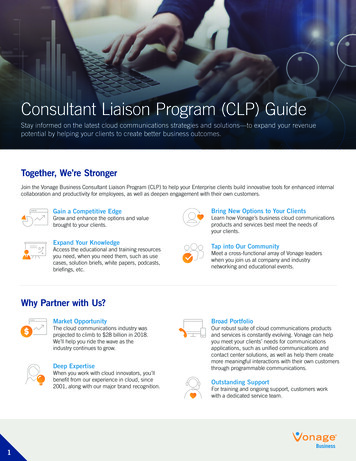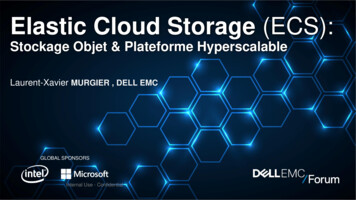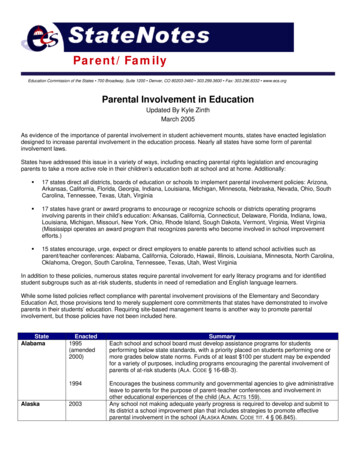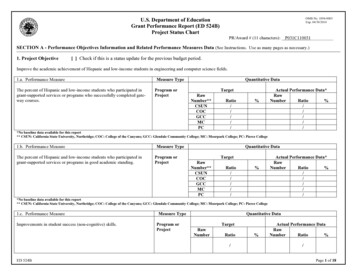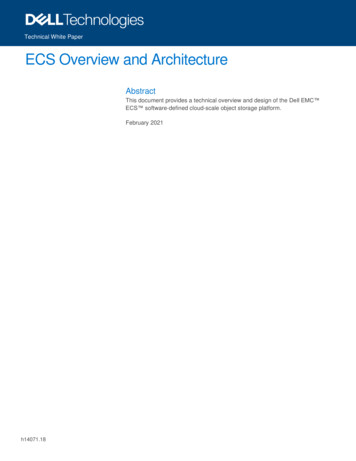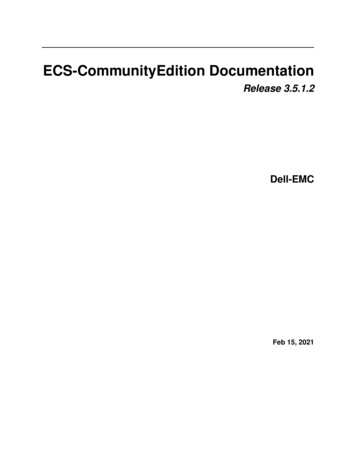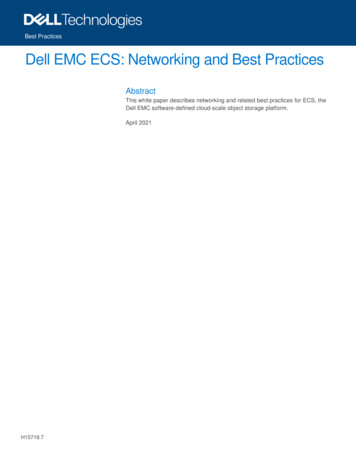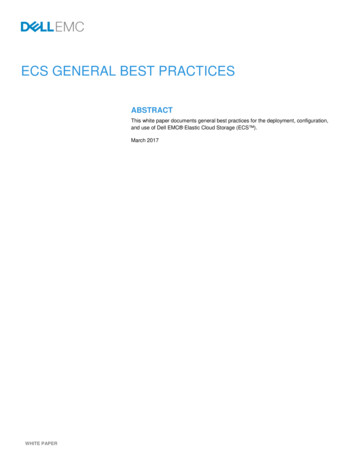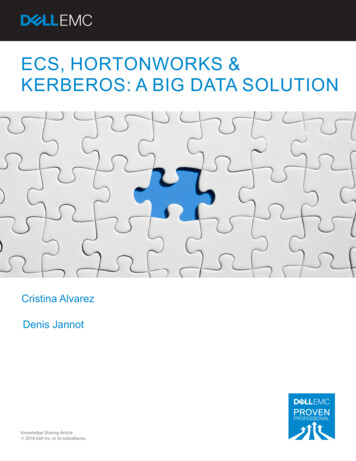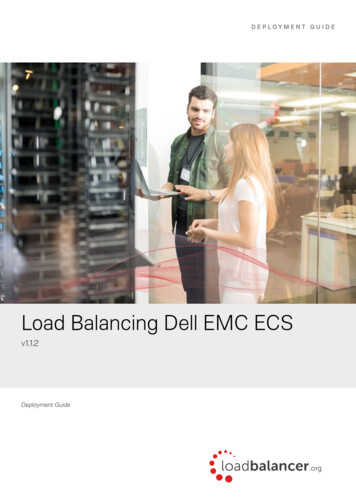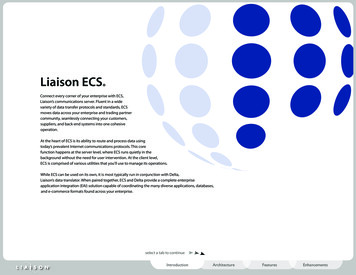
Transcription
Liaison ECS Connect every corner of your enterprise with ECS,Liaison’s communications server. Fluent in a widevariety of data transfer protocols and standards, ECSmoves data across your enterprise and trading partnercommunity, seamlessly connecting your customers,suppliers, and back-end systems into one cohesiveoperation.At the heart of ECS is its ability to route and process data usingtoday’s prevalent Internet communications protocols. This corefunction happens at the server level, where ECS runs quietly in thebackground without the need for user intervention. At the client level,ECS is comprised of various utilities that you’ll use to manage its operations.While ECS can be used on its own, it is most typically run in conjunction with Delta,Liaison’s data translator. When paired together, ECS and Delta provide a complete enterpriseapplication integration (EAI) solution capable of coordinating the many diverse applications, databases,and e-commerce formats found across your enterprise.select a tab to ts
Feature Comparison Across ECS EditionsFeatureECS EditionsLiteStandardEnterpriseUp to 10UnlimitedUnlimitedPPPPPPPPPSMTP ListenerOneUnlimitedUnlimitedHTTP Listener TTP & Secure HTTP POP3 & FTP (Client)PPPPPPPPPPPPPTrading Partner SupportDelta CompatibilityWebECSECS LiteScale-out ProcessingECS Lite is the entry-level version of ECS. This edition provides baselevel communications and processing capabilities for small-to-midsize enterprises that intend to exchange data with no more than 10trading partners. As a streamlined edition of ECS, it does not supportmany top-level features (as noted in the table) that are supported bythe other editions.Integrated Failover TechnologyWeb ServicesPriority Message QueuingECS StandardExecution of Custom Commands/ScriptsECS Standard is a significant leap in functionality from ECS Lite. Itsupports Web services; integration with several security standards;custom scripts and commands; reporting capabilities; advancedevent rule logic; and online access to its operations via WebECS.PManagement ReportsManagement Report SchedulingAdvanced Event Rule HandlingPException HandlingECS EnterpriseData ExceptionsECS Enterprise incorporates all the features of ECS Standard, withthe addition of two major features: scale-out processing andintegrated failover technology. Scale-out processing allows you tomanage the work load over multiple servers. Integrated failovertechnology ensures that if the primary server (controller) fails, aback-up controller provides service in its place. In addition to scaleout and failover capabilities, ECS Enterprise also offers access tothe RosettaNet extensions and the ability to bind certificates at thetrading partner level.Parallel Sessions per ChannelING Bank Protocol ExtensionsRosettaNet HTTP ExtensionsCertificate Binding at TP LevelData Transfer MethodUser-DefinedSFTP & FTP/S AS1/AS2/AS3 ECS Lite can be enhanced with these IntroductionArchitectureSystem RequirementsFeaturesEnhancements
Management ConsoleECS’ Management Console utility governs data flow. You’ll use it to configure where, when,and how ECS retrieves and delivers data, as well as the events that are applied to the data asit travels through ECS.Utilities OverviewData AdministratorECS’ Data Administrator utility presents a window to ECS’ data repository, allowing you toreview repository data; troubleshoot and restage failed communications; and verify whetheritems are received or delivered as expected. Additionally, Data Administrator provides accessto archived data.At the heart of ECS is its ability to route and process data.This core function happens at the server level, where ECSruns quietly in the background without user intervention.Trading Partner ManagerAt the client level, you have access to ECS’ various desktoputilities. You’ll use these utilities to configure how datamoves through ECS, to view and track the data that’spassing through, and to summarize the data. These utilitiesare available locally from your desktop or, if you’re runningthe standard, enterprise, or CX versions of ECS, the majorityof them are also available as parallel Web utilities fromwithin WebECS.The Trading Partner Manager utility stores trading partner information such as sender/receiver IDs, security settings, and EDI formatting requirements. ECS relies on Trading PartnerManager for many functions including data authentication and security application, useraccount management, and recognition of data senders and recipients.Log ViewerThe Log Viewer utility logs all system events that ECS initiates, including communicationssessions, command and script executions, and data translation events to name a few.Although ECS’ client utilities are only briefly overviewedhere, you’ll find more detailed information for many of themas you explore the various feature topics in this brochure.Status MonitorECS’ Status Monitor utility gives you real-time insight into ECS’ operations. You can usethis utility to view and filter current and pending activity, as well as directly affect currentprocesses. For example, you can change data priority, pause and delete work on themessage bus, pause and resume data channels and servers, and view ECS activity in agraphic format.EDI NotepadEDI Notepad is the ultimate EDI editor, providing all those clever features you’ve alwayswanted when working with EDI transactions. These features include several viewing modes,syntax validation for all EDI standards and versions, edit tools to edit or build EDI documents,document delivery capabilities, and automated functional acknowledgment WebECSIntroductionArchitectureSystem RequirementsFeaturesEnhancements
Liaison WebECSThe standard and enterprise versions of ECSship with WebECS, a Web component that letsyou manage various aspects of ECS from yourbrowser. Most of the ECS client utilities thatare available locally from your desktop are alsoavailable as parallel Web utilities from within theWebECS interface, allowing you to configure,track, and summarize your ECS operations fromany computer with a commonly used Webbrowser such as Microsoft Internet Explorer orMozilla Firefox.Secure AccessWebECS can be accessed from your browservia the HTTP or HTTPS protocol. Whether yourconnection to WebECS is secured via SSL is basedon the configurations you establish for ECS’ builtin HTTP listener.Running Reports from SIntroductionArchitectureSystem RequirementsFeaturesEnhancements
Multi-Server DeploymentClustered ECS ServersUsing ECS Enterprise, you can scale out your processing and manage the workloadover a cluster of ECS servers. All ECS servers within a cluster share the same database;when one server is busy, another steps in and handles the processing. For evenmore efficiency, you can “pool” servers in different configurations. For example, youcould create a pool that consists of all servers and assign your most time-sensitiveprocessing to that pool. A second pool could then be created using a subset ofservers for less urgent processing.It’s quite common for companies to run ECS on multiple servers. These ECS serverscan be independent of one another or they can be clustered.Multiple Independent ECS ServersIndependent ECS servers have individual databases and are completely unawareof one another. A typical example of a grouping of independent servers would beseparate development, testing, and production environments. All of ECS’ clientutilities feature helpful tools that allow you to easily register additional ECS serversand move among them.Beyond scale-out processing, ECS Enterprise also offers integrated failovercapabilities. By configuring a backup server, you can avoid downtime in the eventthat the primary server (controller) fails.When you have a group ofclustered ECS Enterprise servers,you can create processing poolsand designate a backup server.When you have multiple independentservers, you can mix the various editionsof ECS as needed. For example, yourdevelopment and test servers could runECS Standard while your productionserver runs ECS Enterprise.Independent ServersEditionsClustered uctionArchitectureSystem RequirementsFeaturesEnhancements
ECS Server System RequirementsComponentMinimum RequirementComputerIntel-Pentium-compatible CPU with 1 GHz or higher processorMemory*2 GB of RAM (4 GB recommended if running on the same computer as Microsoft SQL Server)Hard Disk Space500 MB available disk space (additional space will be required as ECS database grows)Operating SystemMicrosoft Windows Server 2008, Windows Vista, Windows 2003 (Standard, Enterprise, or DataCenter editions), Windows XP Professional, or Windows 7 (Professional edition or better)Microsoft SQL ServerMicrosoft SQL Server 2000 (SP4 or higher), 2005, or 2008Internet ConnectionFull-time connection to the Internet via a dedicated data access line*Maximum recommended batch size should not exceed 125 MB; actual limits may be larger depending on server’s available virtual memoryECS Client System RequirementsComponentMinimum RequirementComputerIntel-Pentium-compatible CPU with 500 MHz or higher processor with a network connectionto the ECS serverMemory1 GB of RAMHard Disk Space100 MB available disk spaceOperating SystemMicrosoft Windows Server 2008, Windows Vista, Windows 2003 (Standard, Enterprise, or DataCenter editions), Windows XP Professional, or Windows 7 (Professional edition or better)Microsoft SQL ServerMicrosoft SQL Server client access license may be required for each client CSIntroductionArchitectureSystem RequirementsFeaturesEnhancements
Data Transfer &Security ProtocolsProtocolsECS communicates using a variety of Internet communications,data transfer, and security protocols. You can use ECS to connectdirectly with your trading partners or you can use Liaison’s valueadded network in conjunction with ECS.StandardsSMTPIETF EDIINT AS1, AS2 and AS3HTTP & HTTPSSOAP, SwAPOP3S/MIMEFTP, FTP/S & SFTPFile systemUser-defined (custom command/script)Using the ECS ManagementConsole utility, you can configuredata to flow into and out of yourenterprise using a variety of datatransfer and security protocols.Data Transfer &Security ProtocolsData FlowManagementException HandlingIntroductionData AdministrationArchitectureSecurityFeaturesTrading PartnerManagementEnhancements
Data Flow ManagementData flow in ECS is governed by input channels, output channels, and event rules. All three ofthese data flow components are configured from ECS’ Management Console utility.Input ChannelsInput channels determine where, when, and how ECS retrieves data. Each inputchannel type has its own unique set of property pages that you will use to set theparameters for the retrieval and processing of data. These parameters, to namejust a few, include where and how often ECS retrieves data, whether duplicatedata should be processed, data authentication settings, and the actions that willbe performed on the data.Output ChannelsOutput channels determine where, when, and how ECS delivers data to externalrecipients or internal applications. ECS can deliver data as soon as it is queued oraccording to a schedule. As with input channels, output channels have uniquesets of property pages for configuring data delivery.Event-Driven ProcessingEvent rules determine how data is processed. For example, event rules forward data tooutput channels, send e-mail messages, and run custom commands and scripts. If Liaison’sdata translator, Delta, is installed, event rules also pass data to Delta for translation andintegration with your back-end systems.Typically, event rules are tied to input channels, telling ECS what to do with data when itarrives. But event rules can also be associated with output channels and even other eventrules to initiate chains of events upon the completion (or failure) of deliveries or events.PrioritizationFor standard and enterprise edition users, data flow prioritization can be established according to atask’s importance to your organization. Every incoming batch receives a priority via the priority assignedto its input channel. As the batch moves through ECS, it retains the highest priority encountered.FTP Input Channel PropertiesData Transfer &Security ProtocolsData FlowManagementException HandlingIntroductionData AdministrationArchitectureSecurityFeaturesTrading PartnerManagementEnhancements
Exception HandlingThe exception-handlingparameters shown here will raisea system-defined “Channel DownException” if ECS is unable toretrieve data via the “FTP-PTMART”input channel for more than 190seconds. An e-mail will be sent toecs support@foxen.com whenthe exception is raised, as well aswhen it is cleared.Some errors require immediate attention. For example, the failure ofan important delivery could have a serious impact on your businessoperations if it goes unnoticed. To ensure that critical errors are broughtto your attention in real time, you can configure ECS to notify you when aparticular type of error (i.e. exception) occurs.ECS supports several types of exceptions:yy System-defined exceptions. These are common types of errors thatECS users universally want to know about such as delivery failures,server failures, or Delta mapping failures.yy User-defined data exceptions. ECS Standard and ECS Enterpriseusers can also create user-defined data exceptions, which monitorthe absence of data. For example, you could configure an exceptionto check for the arrival of monthly production schedules; if aschedule didn’t arrive within so many hours or days of its expectedarrival time, ECS would raise the custom data exception, alerting youto the missing data whose absence might otherwise go unnoticeddue to its infrequency.yy User-defined Delta exceptions. Delta users can identify mappingconditions that cause user-defined Delta exceptions to be raisedin ECS. Unlike ECS’ system-defined mapping exceptions, whichspecifically look for mapping errors, user-defined Delta exceptionscan be raised when any type of mapping condition is met. Forexample, you could create a Delta exception that looked for lineitem quantities in excess of 1000.In addition to notifying theappropriate parties via e-mail, ECSalso posts unhandled exceptionsto the dashboard view of itsManagement Console utility.When the conditions of an exception are met during ECS processing,ECS looks to the exception-handling parameters you’ve defined for thatexception. These parameters include how long ECS should wait beforeraising the exception, as well as who should be notified of the exception—both when it’s raised and when it’s cleared.Data Transfer &Security ProtocolsData FlowManagementException HandlingIntroductionData AdministrationArchitectureSecurityFeaturesTrading PartnerManagementEnhancements
Data Viewing & TrackingAll data that passes through ECS is stored in the ECS data repository. You can view, copy, restage, or restore this data using the Data Administrator utility that ships with ECS. To easilyfind the data you’re looking for, Data Administrator lets you filter data in the ECS repository by a number of criteria—used alone or in combination—including retrieval date, inputchannel, output channel, and delivery status. In addition, you can search for EDI and XML data using document-specific criteria such as document type, interchange control number,and sending or receiving trading partner. When data displays in Data Administrator, not only do you see a wide variety of helpful data attributes, but also the processes applied tothe data as it moved through ECS. For example, an arriving batch of data forever remains associated with the event rule(s) it triggers and the output channel(s) used to move datathrough the enterprise.For each batch of received data, Data Administrator’supper pane displays up to ten data attributesincluding the batch’s arrival date, retrieval method,and sending/receiving trading partners. The lowerpane displays the batch’s associated deliveries, logentries, tracking details, and attachments.Data Transfer &Security ProtocolsData FlowManagementException HandlingIntroductionData AdministrationArchitectureSecurityFeaturesTrading PartnerManagementEnhancements
SecurityECS supports the key aspects of security including access control, privacy, session security, and non-repudiation.Access ControlData SecurityECS manages user access to its various utilities via four predefined roles:To ensure the integrity and non-repudiation of your data, ECS fully supports S/MIME security, including certificate management, document encryption, digitalsignatures, and message disposition notifications (MDNs). ECS also fully supportsthe EDIINT AS1, AS2, and AS3 security specifications, which are built upon S/MIME security features. Throw in SSL/TLS session-level security for FTP, HTTP, andSMTP communications and your data is secure from every angle.yy Restricted users. Read-only access to the ECS database.yy Standard users. Read and write access to the ECS database.yy Power users. Read, write, and delete access to the ECS database.yy Administrators. Unrestricted access to the ECS database, including theability to manage other user accounts.ECS’ AS2 Wizard walks you throughsetting up AS2 communicationsbetween your ECS server and atrading partner’s AS2 server.Data Transfer &Security ProtocolsData FlowManagementException HandlingIntroductionData AdministrationArchitectureSecurityFeaturesTrading PartnerManagementEnhancements
Trading Partner ManagerWatch for occurrences of specific eventsin association with a trading partner.Using Trading Partner Manager (TPM), a utility that ships withECS, you can store a wide variety of information for your tradingpartners such as sender and receiver IDs, security settings, andEDI formatting requirements. In addition to managing tradingpartners from this utility, you’ll also use TPM to manage allECS user accounts.Choose an ECS output channel to deliverdocuments to a trading partner.By storing sender and receiver IDs in TPM, ECS is able tocross-reference the IDs found in incoming and outgoingdata and substitute them for your trading partners’ nameswhen tracking the data in the Data Administrator utilityor generating management reports. In addition, ECS usesthe sender and receiver IDs to watch for data that meetsthe criteria of any event rules that may be assigned to atrading partner’s TPM record.One trading partner can have multiplesets of identifiers.When Delta, Liaison’s data translator, is run in conjunctionwith ECS, TPM helps determine the maps that are runagainst arriving data, functional acknowledgmentgeneration procedures, the sender and receiver IDs thatare applied to outgoing documents, and the ECS outputchannels that outgoing documents are handed off to, tolist just a few of its roles in an ECS/Delta environment.Apply security to all documents sent to aparticular trading partner.Data Transfer &Security ProtocolsData FlowManagementException HandlingIntroductionData AdministrationArchitectureSecurityFeaturesTrading PartnerManagementEnhancements
Integration With DeltaPair ECS with Delta, our data translator, and you have an enterprise application integration (EAI) solution capable of coordinating the many diverseapplications, databases, and e-commerce formats found in your enterprise. In this role as middleware, the two applications work seamlessly together,with ECS delivering data to Delta for translation and then picking it up again for delivery to external trading partners or internal back-end systems.When ECS passes arriving EDI or XML data to Delta, Delta uses the data’s content to automatically determine the appropriate map(s) to run. In addition, you c
Liaison ECS Connect every corner of your enterprise with ECS, . EDI Notepad EDI Notepad is the ultimate EDI editor, providing all those clever features you’ve always wanted when working with EDI transactions. These features include several viewing modes, syntax validation for all ED

